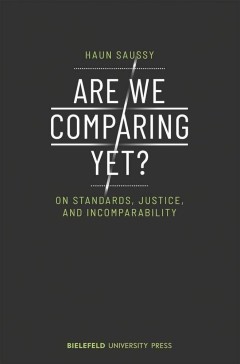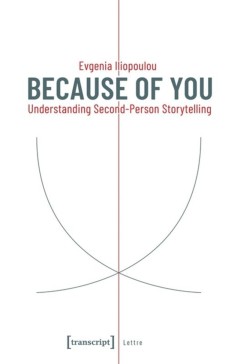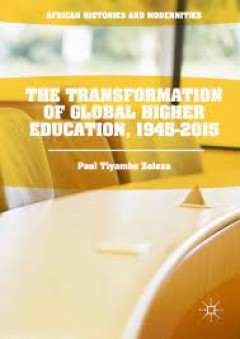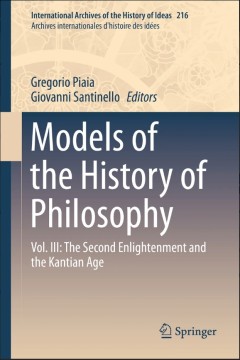Filter by

Are We Comparing Yet? : On Standards, Justice, and Incomparability
Debates about the possibility of an open culture - or indeed about the possibility of an open debate about the openness of culture - often turn on questions of standards. But since no benchmark can be absolute, judgement is a proliferation of comparisons.Through a series of case studies in everyday and academic comparison (literature, history, politics, philosophy), Haun Saussy calls out the ty…
- Edition
- -
- ISBN/ISSN
- 9783839449776
- Collation
- -
- Series Title
- -
- Call Number
- 306 SAU a

Because of You : Understanding Second-Person Storytelling
Second-person storytelling is a continually present and diverse technique in the history of literature that appears only once in the oeuvre of an author. Based on key narratives of the post-war period, Evgenia Iliopoulou approaches the phenomenon in an inductive way, starting out from the essentials of grammar and rhetoric, and aims to improve the general understanding of second-person narrativ…
- Edition
- -
- ISBN/ISSN
- 9783839445372
- Collation
- 256 halaman
- Series Title
- -
- Call Number
- 800 ILI b

Aspects of Poverty and Inequality in Cameroon
Poverty and inequality remain extremely high for Cameroon despite improvements in poverty figures between 1996 and 2001. To understand the dynamics of poverty and inequality between 1996 and 2001, this book develops a poverty and inequality profile, investigates the sources of inequality along spatial lines and simulates some policies which could be used in the reduction of poverty and inequali…
- Edition
- -
- ISBN/ISSN
- 9783631595350
- Collation
- 171 halaman
- Series Title
- -
- Call Number
- 362 KUM a

Articulating Bodies : The Narrative Form of Disability and Illness in Victori…
Articulating Bodies investigates the contemporaneous developments of Victorian fiction and disability’s medicalization by focusing on the intersection between narrative form and body. The book examines texts from across the century, from Frederic Shoberl’s 1833 English translation of Victor Hugo’s Notre-Dame de Paris to Arthur Conan Doyle’s Sherlock Holmes story “The Adventure of the …
- Edition
- -
- ISBN/ISSN
- 9781789624953
- Collation
- -
- Series Title
- Representations : Health, Disability, Culture and Society
- Call Number
- 800 HIN a

Administrating Kinship: Marriage Impediments and Dispensation Policies in the…
From the late eighteenth century, more and more men and women wanted to marry their cousins or in-laws. In this case, bridal couples had to apply for a papal dispensation and this meant a hurdled, lengthy and also expensive procedure. This book shows that applicants in four dioceses – Brixen, Chur, Salzburg and Trent – took very different paths through the thicket of bureaucracy to achieve …
- Edition
- -
- ISBN/ISSN
- 9789004539877
- Collation
- -
- Series Title
- -
- Call Number
- -

The Vienna Circle Studies in the Origins, Development, and Influence of Logi…
This abridged and revised edition of the original book (Springer-Wien-New York: 2001) offers the only comprehensive history and documentation of the Vienna Circle based on new sources with an innovative historiographical approach to the study of science. With reference to previously unpublished archival material and more recent literature, it refutes a number of widespread clichés about "neo-p…
- Edition
- -
- ISBN/ISSN
- 978-3-319-16561-5
- Collation
- -
- Series Title
- -
- Call Number
- -

The Transformation of Global Higher Education, 1945-2015
This book explores some of the major forces and changes in higher education across the world between 1945 and 2015. This includes the explosions of higher education institutions and enrollments, a development captured by the notion of massification. There were also profound shifts in the financing and economic role of higher education reflected in the processes of privatization of universities …
- Edition
- -
- ISBN/ISSN
- 978-1-137-52869-8
- Collation
- -
- Series Title
- -
- Call Number
- -

Feeling and Value, Willing and Action Essays in the Context of a Phenomenolo…
This volume explores the role and status of phenomena such as feelings, values, willing, and action in the domain of perception and (social) cognition, as well as the way in which they are related. In its exploration, the book takes Husserl’s lifelong project Studien zur Struktur des Bewusstseins (1909-1930) as its point of departure, and investigates these phenomena with Husserl but also bey…
- Edition
- -
- ISBN/ISSN
- 978-3-319-10326-6
- Collation
- VIII, 291
- Series Title
- -
- Call Number
- -

Vladimir Solov’ëv's Justification of the Moral Good Moral Philosophy
This new English translation of Solov’ëv’s principal ethical treatise, written in his later years, presents Solov’ëv’s mature views on a host of topics ranging from a critique of individualistic ethical systems to the death penalty, the meaning of war, animal rights, and environmentalism. Written for the educated public rather than for a narrow circle of specialists, Solov’ëv’s w…
- Edition
- -
- ISBN/ISSN
- 978-3-319-12775-0
- Collation
- LXX, 435
- Series Title
- -
- Call Number
- -

Models of the History of Philosophy:Vol. III: The Second Enlightenment and th…
This is the third volume of Models of the History of Philosophy, a collaborative work on the history of the history of philosophy dating from the Renaissance to the end of the nineteenth century. The volume covers a decisive period in the history of modern thought, from Voltaire and the great “Encyclopédie” of Diderot and d'Alembert to the age of Kant, i.e. from the histoire de l'esprit hu…
- Edition
- 1
- ISBN/ISSN
- 978-94-017-9965-2
- Collation
- XXXII, 1000
- Series Title
- International Archives of the History of Ideas Archives internationales d'histoire des idées
- Call Number
- -
 Computer Science, Information & General Works
Computer Science, Information & General Works  Philosophy & Psychology
Philosophy & Psychology  Religion
Religion  Social Sciences
Social Sciences  Language
Language  Pure Science
Pure Science  Applied Sciences
Applied Sciences  Art & Recreation
Art & Recreation  Literature
Literature  History & Geography
History & Geography